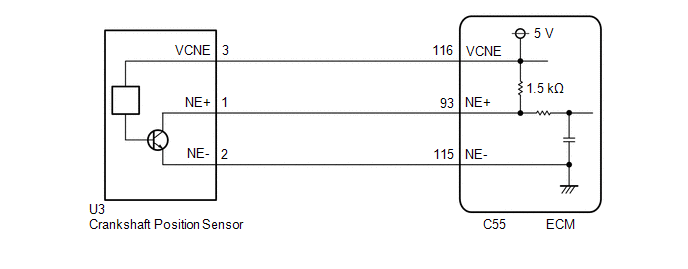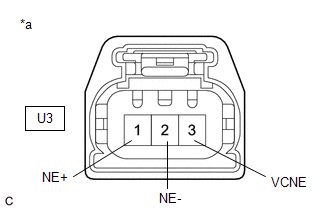DESCRIPTION The crankshaft
position sensor system consists of a No. 1 crankshaft position sensor
plate and Magneto Resistance Element (MRE) type sensor. The No. 1
crankshaft position sensor plate has 34 teeth at 10° intervals (2 teeth
are missing for detecting top dead center), and is installed on the
crankshaft. The crankshaft position sensor generates 34 signals per
crankshaft revolution. The ECM uses the crankshaft position sensor
signal (NE signal) to detect the crankshaft position and engine speed. |
DTC No. | Detection Item |
DTC Detection Condition | Trouble Area |
MIL | Memory |
Note | | P033511 |
Crankshaft Position Sensor "A" Circuit Short to Ground |
The crankshaft position sensor output voltage is less than 0.3 V for 4 seconds or more (1 trip detection logic). |
- Open or short in crankshaft position sensor circuit
- Crankshaft position sensor
- ECM
| Comes on |
DTC stored | SAE Code: P0337 | |
P033515 | Crankshaft Position Sensor "A" Circuit Short to Battery or Open |
The crankshaft position sensor output voltage is higher than 4.7 V for 4 seconds or more (1 trip detection logic). |
- Open or short in crankshaft position sensor circuit
- Crankshaft position sensor
- ECM
| Comes on |
DTC stored | SAE Code: P0338 |
MONITOR DESCRIPTION If
the output voltage transmitted by the crankshaft position sensor
remains low or high, the ECM interprets this as a malfunction in the
sensor circuit, illuminates the MIL and stores a DTC. MONITOR STRATEGY |
Related DTCs | P0337: Crankshaft position sensor range check (Low voltage)
P0338: Crankshaft position sensor range check (High voltage) | |
Required Sensors/Components (Main) | Crankshaft position sensor | |
Required Sensors/Components (Related) |
Camshaft position sensor | |
Frequency of Operation | Continuous | |
Duration | 4 seconds | |
MIL Operation | Immediate | |
Sequence of Operation | None | TYPICAL ENABLING CONDITIONS |
Monitor runs whenever following DTCs are not present |
None | | Both of the following conditions are met |
- | | Auxiliary battery voltage |
8 V or higher | | Power switch |
On (IG) | TYPICAL MALFUNCTION THRESHOLDS P0337: Range Check (Low Voltage) |
Crankshaft position sensor voltage | Less than 0.3 V | P0338: Range Check (High Voltage) |
Crankshaft position sensor voltage | Higher than 4.7 V | CONFIRMATION DRIVING PATTERN
HINT:
- After repair has been completed, clear the DTC and then check that the
vehicle has returned to normal by performing the following All Readiness
check procedure.
Click here 
- When clearing the permanent DTCs, refer to the "CLEAR PERMANENT DTC" procedure.
Click here 
- Connect the Techstream to the DLC3.
- Turn the power switch on (IG).
- Turn the Techstream on.
- Clear the DTCs (even if no DTCs are stored, perform the clear DTC procedure).
- Turn the power switch off and wait for at least 30 seconds.
- Turn the power switch on (IG) [A].
- Turn the Techstream on.
- Wait 5 seconds or more [B].
- Enter the following menus: Powertrain / Engine / Trouble Codes [C].
- Read the pending DTCs.
HINT:
- If a pending DTC is output, the system is malfunctioning.
- If a pending DTC is not output, perform the following procedure.
- Enter the following menus: Powertrain / Engine / Utility / All Readiness.
- Input the DTC: P033511 or P033515.
- Check the DTC judgment result.
|
Techstream Display |
Description |
|
NORMAL |
- DTC judgment completed
- System normal
|
|
ABNORMAL |
- DTC judgment completed
- System abnormal
|
|
INCOMPLETE |
- DTC judgment not completed
- Perform driving pattern after confirming DTC enabling conditions
|
HINT:
WIRING DIAGRAM
 CAUTION / NOTICE / HINT
NOTICE:
HINT:
- The engine speed can be checked by using the Techstream. To perform the check, follow the procedures below:
- Connect the Techstream to the DLC3.
- Turn the power switch on (IG).
- Turn the Techstream on.
- Put the engine in Inspection Mode (Maintenance Mode).
Click here 
- Start the engine.
- Enter the following menus: Powertrain / Engine / Data List / Engine Speed.
- The engine speed may be indicated as zero despite the engine running
normally. This is caused by a lack of NE signals from the crankshaft
position sensor. Alternatively, the engine speed may be indicated as
lower than the actual engine speed if the crankshaft position sensor
output voltage is insufficient.
- Read Freeze Frame Data using the Techstream. The ECM records vehicle and
driving condition information as Freeze Frame Data the moment a DTC is
stored. When troubleshooting, Freeze Frame Data can help determine if
the vehicle was moving or stationary, if the engine was warmed up or
not, if the air fuel ratio was lean or rich, and other data from the
time the malfunction occurred.
PROCEDURE |
1. | READ VALUE USING TECHSTREAM (ENGINE SPEED) |
(a) Connect the Techstream to the DLC3. (b) Turn the power switch on (IG).
(c) Turn the Techstream on. (d) Put the engine in Inspection Mode (Maintenance Mode). Powertrain > Hybrid Control > Utility
|
Tester Display | | Inspection Mode |
(e) Start the engine. (f) Enter the following menus: Powertrain / Engine / Data List / Engine Speed. Powertrain > Engine > Data List
|
Tester Display | | Engine Speed |
(g) Read the values displayed on the Techstream while the engine is running.
Standard: Correct values are displayed.
HINT:
- To check the engine speed change, display the graph on the Techstream.
- If the engine does not start, check the engine speed while cranking.
- If the engine speed indicated on the Techstream remains at zero (0),
there may be an open or short in the crankshaft position sensor circuit.
| OK |
 | CHECK FOR INTERMITTENT PROBLEMS |
|
NG |
 | |
| 2. |
CHECK HARNESS AND CONNECTOR |

|
*a | Front view of wire harness connector
(to Crankshaft Position Sensor) | HINT:
Make sure that the connector is properly connected. If it is not, securely connect it and check for DTCs again.
(a) Disconnect the crankshaft position sensor connector. (b) Turn the power switch on (IG).
(c) Measure the voltage according to the value(s) in the table below. Standard Voltage: |
Tester Connection | Condition |
Specified Condition | |
U3-3 (VCNE) - Body ground |
Power switch on (IG) |
4.5 to 5.5 V | |
U3-1 (NE+) - Body ground |
Power switch on (IG) |
3.0 to 5.0 V | (d) Turn the power switch off and wait for at least 30 seconds.
(e) Measure the resistance according to the value(s) in the table below.
Standard Resistance: |
Tester Connection | Condition |
Specified Condition | |
U3-3 (VCNE) - U3-1 (NE+) |
Power switch off | 1.425 to 1.575 kΩ | |
U3-2 (NE-) - Body ground |
Always | Below 1 Ω |
| OK |
 | REPLACE CRANKSHAFT POSITION SENSOR |
|
NG |
 | |
| 3. |
CHECK HARNESS AND CONNECTOR (CRANKSHAFT POSITION SENSOR - ECM) |
(a) Disconnect the crankshaft position sensor connector. (b) Disconnect the ECM connector.
(c) Measure the resistance according to the value(s) in the table below.
Standard Resistance: |
Tester Connection | Condition |
Specified Condition | |
U3-3 (VCNE) - C55-116 (VCNE) |
Always | Below 1 Ω | |
U3-2 (NE-) - C55-115 (NE-) |
Always | Below 1 Ω | |
U3-1 (NE+) - C55-93 (NE+) |
Always | Below 1 Ω | |
U3-3 (VCNE) or C55-116 (VCNE) - Body ground and other terminals |
Always | 10 kΩ or higher | |
U3-2 (NE-) or C55-115 (NE-) - Body ground and other terminals |
Always | 10 kΩ or higher | |
U3-1 (NE+) or C55-93 (NE+) - Body ground and other terminals |
Always | 10 kΩ or higher |
| OK |
 | REPLACE ECM |
| NG |
 | REPAIR OR REPLACE HARNESS OR CONNECTOR | | 
